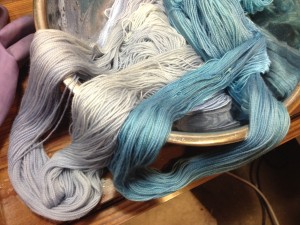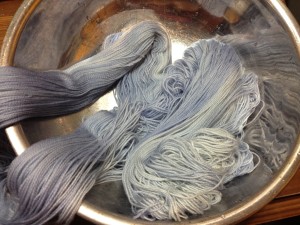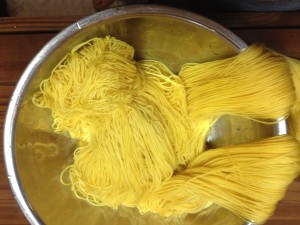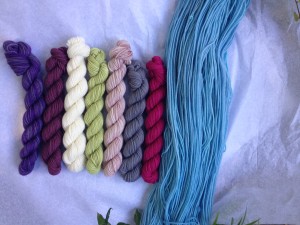This is basically the e-mail that Kate sent me, showing her process in creating the 8th color for an Astoria Sock kit, as we contemplate a KAL (knit-a-long). I found it so fascinating that I asked her if I could share, and she agreed. I am continually amazed and intrigued with the dying process – the artistry and patience involved, as well as the science. Don’t forget to vote, in the comments, on which color we should choose! See yesterday’s blog post for full details.
Guest blog: Kate Bachus (A Hundred Ravens)
All right, here’s some stuff!
I knew I wanted to try both a warmer blue and a cooler blue, because there are both warm and cool color combinations in the minis. I knew a true warm would definitely work; I wasn’t sure about a true cool, so I started with a warm blue in both cases. This blue is a combination of midnight blue and black. Two skeins! I was happy with this blue for the warm, so I went on to the cooler blue.

For the second skein, I overdyed the first color with a very little bit of a cool, florescent blue. I was happy with this one too, so I set both these blues aside. Blues are pretty easy, and almost any blue looks good! Plus people like blues and purples, so dyers get a lot of practice working with those shades. I can do blues in my sleep! :D
Yellow, however, is not so easy at all. The world is full of some truly awful yellows, and even of the decent yellows, it’s hard to get people to agree on a color they like. You’d said “buttery,” I think, and that was a good jumping off point. Our house yellow, Apollo, is a very strong, golden, bright yellow. It has a hit of red in it to make it gold, but it’s nothing like what I picture when I think “buttery.”
The first yellow was a disaster. In fact, it was orange!! I’m used to working with a cool yellow primary for the most part, and I’d gone warm for our yellow. I didn’t realize how little red it would take to make orange with that yellow. Whoops! Back to the drawing board.
Well… at least it was yellow and not orange?
This might, *might* be a good yellow for baby things. I think. Maybe not. Regardless, it was pretty anemic so I doubled the recipe I’d just used. Because despite it being anemic, it did seem to have the right tone…
Much better! I’d wound up with a warm, buttery yellow that once it dried and lightened (you have to factor that in when you’re judging the quality of a color on a wet skein!), might nicely compliment the existing colors.
Speaking of, once the skeins were cooked and dried, I set them out next to the other colors. Here’s how they look!
(Although these were taken outside, photos are notoriously bad — particularly my photos! — for getting true yarn colors, so allow for that…)








Stacie